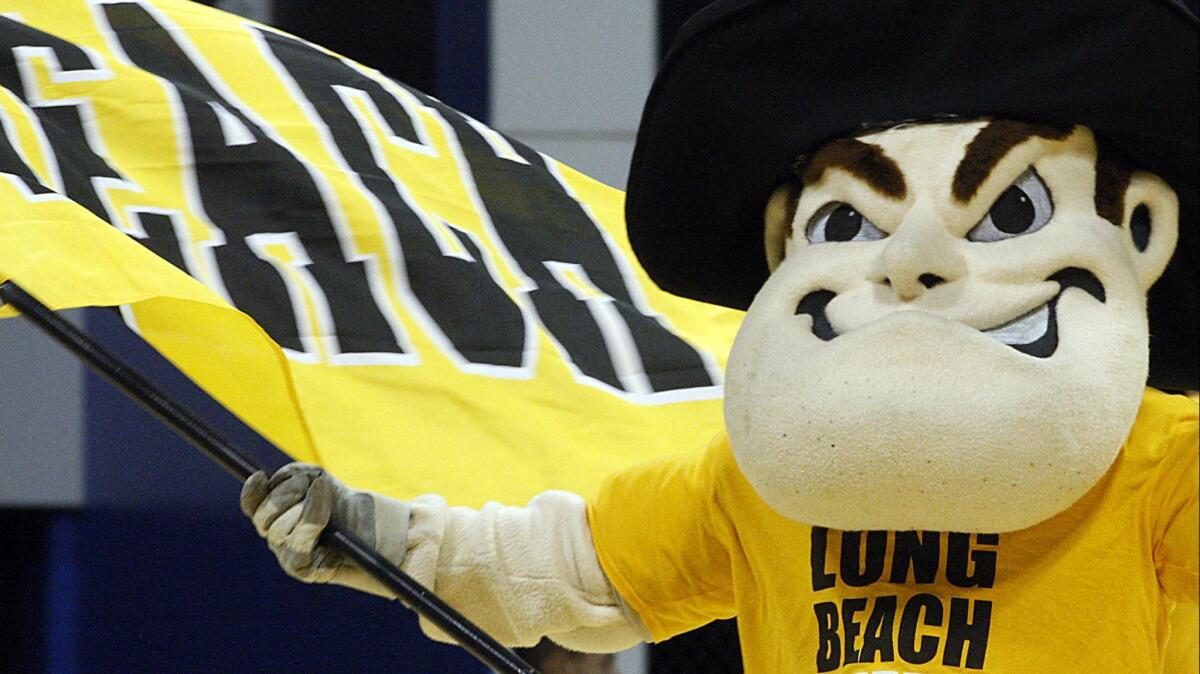Column: Cal State Long Beach’s 49ers have a complicated history, but it’s one worth rooting for

- Share via
Let’s play word association, California edition. The topic is “49ers.” What comes to mind? The gold rush, of course. A football team in San Francisco, for sure. A grizzled prospector with a burro and a pickax, probably. “Oh My Darling, Clementine” for us old-timers.
How about “genocidal maniacs”?
That’s the association the student senate at Cal State Long Beach is debating. Before the group is a resolution titled “Retirement of Prospector Pete and Dissociation from the Gold Rush Era” on which the student government will vote before the end of the spring semester on May 25. This is the latest class of 49ers to wrestle with the legacy of the university’s sports teams’ nickname, their Jay Leno-looking mascot and a statue colloquially called “Prospector Pete” that watches over the campus quad.
“Multiple scholars have cited the California Prospectors, also known as the ’49ers,’ ” the resolution reads, “as culpable in violent and genocidal acts against the Indigenous people of California.”
Compounding the sensitivity in Long Beach is the issue that the campus stands within Puvungna, a village for the Tongva people who called most of what’s now Los Angeles County their own until Junipero Serra set up the mission system. The area also is sacred for other Southern California tribes who believe this is where Chinigchinich, an important deity in their religions, revealed himself. As a result, Native American activists have been at odds with the university for decades, especially after school officials tried to lease a stretch of Puvungna to a developer in the early 1990s.
Think even more broadly about the history you profess represents nothing but evil.
The student senate vote is advisory. It’s a committee of administrators, faculty, students and alumni that ultimately will decide Pete’s future. The school has largely phased out the 49ers name over the past couple of decades by pushing the alternative rallying cry, “Go Beach!”
These developments have upset many Cal State Long Beach alumni and brought forth the ridicule of conservative critics, who dismiss the student senate’s effort as politically correct posturing. I say they are merely following the grand California tradition of choosing other mascots when a new generation finds the old one offensive (like Stanford’s swap of Indians to the Cardinal in 1972) or wants to mock the whole idea of school mascots (hence, the UC Santa Cruz Banana Slugs or UC Irvine Anteaters).
But to the current Cal State Long Beach 49ers who hate their nickname, I offer this challenge: Think even more broadly about the history you profess represents nothing but evil.
Did people during the gold rush kill Indians in California? Absolutely. In his masterful 2016 book “An American Genocide: The United States and the California Indian Catastrophe, 1846-1873,” UCLA history professor Benjamin Madley documented how vigilantes, soldiers and regular citizens slaughtered California’s native population to the point that it went from about 150,000 people to just 30,000. (To see how those same Yankees also savaged the Mexicans during that era, read “The Decline of the Californios” by the late Cal State Northridge professor Leonard Pitt).
Did all 49ers do it? No.
Until I learned about the Cal State Long Beach debate, I always took “49ers” to symbolize an idea larger than men mining for nuggets. After John Sutter struck gold, to paraphrase the title of a famous book about the era, the world rushed in to California. It was a massive, global population shift and also the birth of a state of mind.
The California dream — the belief that opportunity lives here — still shapes us, whether our ancestors were Okies or Iowans, whether we’re Honduran refugees or wealthy Persians. That gold rush spirit is what makes this the best state and leaves pretenders like Tennessee or Texas clutching for volunteers and longhorns or whatever collective myths they teach kids.
Prospectors were more complicated than the stereotype. They derided the worst among themselves as “Pikers,” a reference to those from Pike County, Mo., who had a reputation for ruthlessness). Even decades later, the legendary satirist H.L. Mencken described California’s Pikers as a “singularly backward type of yokel.”
The 49ers weren’t all white either. At Cal State Long Beach, the campus statue should be renamed Prospector Pedro, to honor the Mexicans, Chileans and Peruvians who came over in the 1850s. Or the Chinese equivalent of Peter. It was Latino and Asian immigrants who introduced mining techniques to the gold camps that everyone else copied. And their reward? Lynchings and discriminatory laws passed by the California Legislature.
I’ll respect whatever Cal State Long Beach decides to do with Prospector Pete and the 49ers nickname — I’m a UCLA Bruin, anyway. But the university has a powerful opportunity to reclaim the term 49er and teach the rest of California about our complex history.
The school could take a cue from the students at Savanna High School in Anaheim. For decades, its Rebels nickname was a direct reference to the Confederacy. Stars and Bars decorated the gym, and the high school marching band blasted “Dixie” during rallies before a statue of Johnny Reb. Last year, students decided to ditch the Confederate claptrap but keep the Rebels name.
Go, Beach.
Twitter: @gustavoArellano
More to Read
A cure for the common opinion
Get thought-provoking perspectives with our weekly newsletter.
You may occasionally receive promotional content from the Los Angeles Times.







